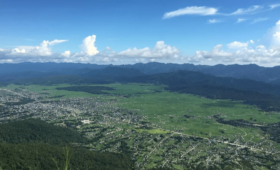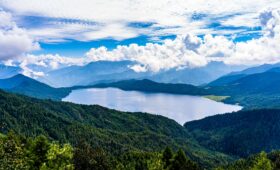Introduction
Nestled at the confluence of Ridi Khola and Kaligandaki River in western Nepal, Ruru Kshetra, also known as Ridi, is a captivating religious and cultural destination. It holds great significance as one of the Char Dhams in Nepal, attracting pilgrims and travelers from all corners of the world. Ruru Kshetra is renowned for its age-old fair, Ridi Mela, held during Maghe Sankranti, and its rich history and religious heritage make it a must-visit site. In this blog, we will delve into the enchanting allure of Ruru Kshetra, highlighting its religious importance, stunning landmarks, and the unique experiences it offers to visitors.
Religious Significance and Rishikesh Temple:
Ruru Kshetra holds immense religious significance in Nepal. According to ancient scriptures, Ruru Kshetra is one of the four sacred religious centers for Hindus in Nepal, along with Muktikshetra, Barahakshetra, and Pashupatikshetra. It is believed that taking a holy bath in the Kaligandaki River for three days during the Maghesankranti festival and worshiping at the Rishikesh Temple can lead to spiritual liberation or Moksha.
The Rishikesh Temple complex in Ruru Kshetra is a marvel in itself. It is dedicated to Lord Vishnu and Ruru Kanya, featuring a four-armed stone image inside the Hrishikeshav Temple. The temple complex has deep-rooted historical and mythological significance, as it is believed that Ruru, a mythological girl, meditated here and pleased Lord Vishnu, who decided to stay in this sacred place forever. The Rishikesh Temple has even been included in the tentative list of UNESCO World Heritage sites.
Captivating Landmarks and Natural Beauty
Ruru Kshetra: A Majestic and Alluring Pilgrimage Site in Western Nepal
Ruru Kshetra is aptly referred to as the “Banaras of Nepal” due to its resemblance to the holy city of Varanasi. The serene and picturesque surroundings of Ruru Kshetra make it a paradise for nature lovers and spiritual seekers alike. The area is encompassed by verdant hills, offering breathtaking views and a tranquil ambiance.
Srinagar Hill, located just half a kilometer away, presents a majestic ridge covered in dense pine forests. It is a popular spot for nature enthusiasts, meditation practitioners, and those seeking stunning vistas of the Himalayan Range, Madi Valley, and Mahabharat Mountains. The hill is also home to the Parileyak Ban, where a magnificent stone-carved statue of Lord Buddha resides, providing a perfect vantage point for observing mesmerizing sunrises and sunsets.
Bhusal Danda, situated 3 kilometers from Ruru Kshetra, is famous for the UMN Hospital, attracting numerous individuals seeking better medical treatment. The Lions guesthouse and covered hall for indoor games cater to the needs of patients and their families.
The historic Tansen Durbar, also known as the Singh Durbar of Palpa, is another must-visit landmark in Ruru Kshetra. Constructed in 1927 AD by General Pratap Shamsher, this four-storied palace with its sixty-three rooms, meeting halls, and minarets showcases the architectural brilliance of the past.
Ridi Mela and Festivals
Ruru Kshetra: A Majestic and Alluring Pilgrimage Site in Western Nepal
Ruru Kshetra comes alive during the annual Ridi Mela, a vibrant fairthat takes place during Maghe Sankranti, which usually falls in January. Ridi Mela is a grand celebration where devotees from far and wide gather to participate in religious rituals, cultural performances, and various festive activities.
During the fair, the entire Ruru Kshetra is adorned with colorful decorations, creating a festive atmosphere. Pilgrims take holy dips in the Kaligandaki River, considered a sacred act that purifies the soul and brings blessings. The riverbank becomes a hub of religious fervor, with devotees performing rituals, offering prayers, and lighting oil lamps.
The fair also features a bustling marketplace where visitors can indulge in local delicacies, shop for traditional handicrafts, clothes, and jewelry. Traditional music, dance performances, and cultural shows add to the vibrant ambiance of the Ridi Mela, showcasing the rich cultural heritage of the region.
Apart from Ridi Mela, Ruru Kshetra hosts several other festivals throughout the year, attracting both locals and tourists. Some of the prominent festivals celebrated in Ruru Kshetra include Rishikesh Janmashtami, Ram Navami, Dashain, and Tihar. These festivals provide an opportunity to witness the local traditions, customs, and religious practices, giving visitors a deeper insight into the cultural fabric of the region.
Conclusion:
Ruru Kshetra: A Majestic and Alluring Pilgrimage Site in Western Nepal
Ruru Kshetra, with its religious significance, stunning landmarks, and vibrant festivals, is a mesmerizing pilgrimage site in western Nepal. Whether it’s the spiritual experience of bathing in the Kaligandaki River, the awe-inspiring Rishikesh Temple, or the natural beauty of Srinagar Hill and Bhusal Danda, Ruru Kshetra offers a captivating journey for seekers of divinity and nature lovers alike. The annual Ridi Mela adds a vibrant touch to the pilgrimage site, making it an even more enticing destination. A visit to Ruru Kshetra promises an unforgettable blend of spirituality, culture, and natural splendor.



